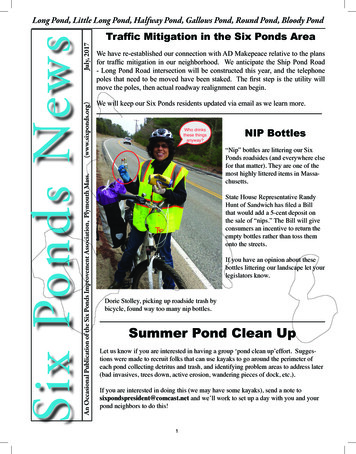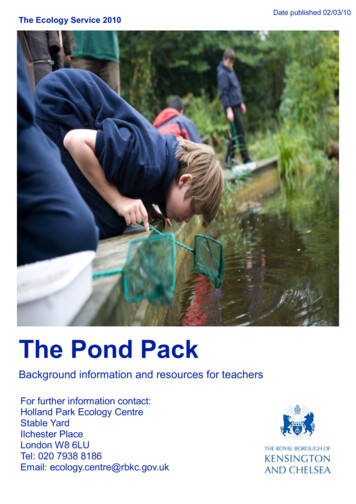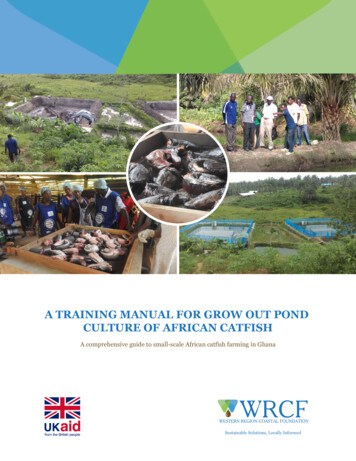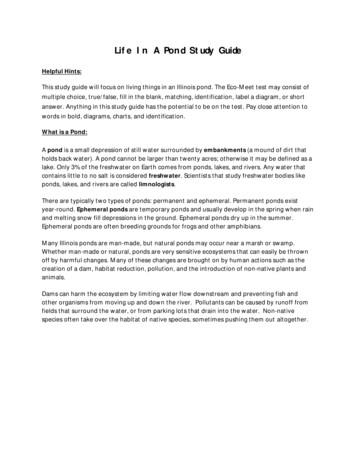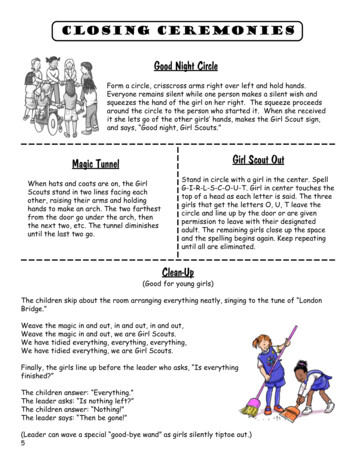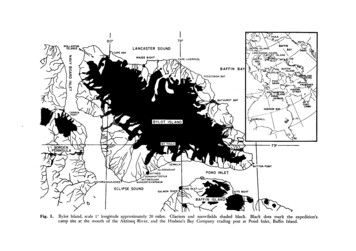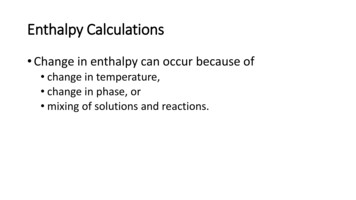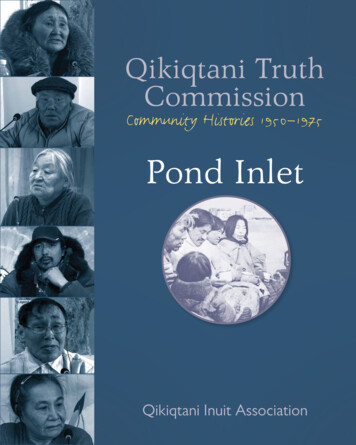
Transcription
Qikiqtani TruthCommissionCommunity Histories 1950–1975Pond InletQikiqtani Inuit Association
Published by Inhabit Media Inc.www.inhabitmedia.comInhabit Media Inc. (Iqaluit), P.O. Box 11125, Iqaluit, Nunavut, X0A 1H0(Toronto), 146A Orchard View Blvd., Toronto, Ontario, M4R 1C3Design and layout copyright 2013 Inhabit Media Inc.Text copyright 2013 Qikiqtani Inuit AssociationPhotography copyright 2013 Library and Archives Canada, Northwest Territories Archives,and Tim KalushaOriginally published in Qikiqtani Truth Commission: Community Histories 1950–1975 by Qikiqtani InuitAssociation, April 2014.ISBN 978-1-927095-62-1All rights reserved. The use of any part of this publication reproduced, transmitted in any form or by anymeans, electronic, mechanical, photocopying, recording, or otherwise, or stored in a retrievable system,without written consent of the publisher, is an infringement of copyright law.We acknowledge the support of the Government of Canada through the Department of Canadian HeritageCanada Book Fund program.We acknowledge the support of the Canada Council for the Arts for our publishing program.Please contact QIA for more information:Qikiqtani Inuit AssociationPO Box 1340, Iqaluit, Nunavut, X0A 0H0Telephone: (867) 975-8400Toll-free: 1-800-667-2742Fax: (867) 979-3238Email: info@qia.ca
ErrataDespite best efforts on the part of the author, mistakes happen.The following corrections should be noted when using this report:Administration in Qikiqtaaluk was the responsibility of one or more federaldepartments prior to 1967 when the Government of the Northwest Territorieswas became responsible for the provision of almost all direct services. Theterm “the government” should replace all references to NANR, AANDC,GNWT, DIAND.p. 20: In 1921, a party of Danish and Greenlandic scientific adventurerslaunched the Fifth Thule Expedition, a remarkable four-year venture movingfrom Greenland to Alaska, to document Inuit culture and, through archaeology and ethnography to investigate the origins of Inuit as a people.p. 33: None of these things was harmful in itself, but they created newdemands and new relationships. 3
DedicationThis project is dedicated to the Inuit of the Qikiqtani region.May our history never be forgotten and our voices beforever strong. 5
ForewordAs President of the Qikiqtani Inuit Association, I am pleased topresent the long awaited set of reports of the Qikiqtani TruthCommission.The Qikiqtani Truth Commission: Community Histories 1950–1975and Qikiqtani Truth Commission: Thematic Reports and Special Studiesrepresent the Inuit experience during this colonial period, as told by Inuit.These reports offer a deeper understanding of the motivations driving government decisions and the effects of those decisions on the lives of Inuit,effects which are still felt today.This period of recent history is very much alive to Qikiqtaalungmiut,and through testifying at the Commission, Inuit spoke of our experience ofthat time. These reports and supporting documents are for us. This workbuilds upon the oral history and foundation Inuit come from as told by Inuit,for Inuit, to Inuit.On a personal level this is for the grandmother I never knew, becauseshe died in a sanatorium in Hamilton; this is for my grandchildren, so that6
Foreword 7they can understand what our family has experienced; and it is also for theyoung people of Canada, so that they will also understand our story.As it is in my family, so it is with many others in our region.The Qikiqtani Truth Commission is a legacy project for the people ofour region and QIA is proud to have been the steward of this work.Aingai,E7-1865J. Okalik EegeesiakPresidentQikiqtani Inuit AssociationIqaluit, Nunavut2013
8 Qikiqtani Truth Commission: Community Histories 1950–1975
Pond InletMittimatalikPond Inlet is a hamlet of 1,549 people, 92% of them Inuit. It is locatedon the east side of Eclipse Sound, about 700 kilometres north of theArctic Circle on Baffin Island. The local name in the Inuit language isMittimatalik, and the people of the region are known as Tununirmiut, whichis thought to mean “people of the shaded place” or Mittimatalingmiut, meaning “people of Mittimatalik.” The hamlet shares its name with an arm of thesea that separates Bylot Island from Baffin Island. The place name “Pond’sBay” was chosen by an explorer in 1818 in honour of an English astronomer.The region has been occupied for four thousand years, through periodsknown to archaeologists as pre-Dorset, Dorset, Thule, and modern Inuit.Since the earliest times, people hunted on land, sea, and ice. Ringed seals,whales, and other marine mammals have been the most important partof their diet. Evidence of a rich material and intangible culture is providedby cultural objects preserved in the ground, most famously two superbshaman’s masks carved more than a thousand years ago, which were foundat Button Point. Many of the present-day residents of Pond Inlet are relatedto families in Igloolik. 9
10 Qikiqtani Truth Commission: Community Histories 1950–1975The settlement grew along a shoreline inhabited as long as any otherpart of Eclipse Sound. The area’s twentieth-century use by Qallunaat traders extended 65 kilometres from Button Point on Bylot Island to SalmonRiver near the hamlet. Trading establishments have only been here since1903, when Scottish entrepreneurs set up a small whaling station at Igarjuaq. Over the next twenty years, Qallunaat managers opened a numberThe RomanCatholic Mission atPond Inlet, 1951of small stations scattered around this region. The Hudson’s Bay Companylibrary and archivesAnglican) came in 1929. The site is convenient to ocean shipping during thecanada(HBC) settled at the present site in 1921 and bought out all its rivals by1923. The RCMP post dates to 1922 and two missions (Roman Catholic andshort season of open water.
Community TimelineOutsider EventsDate Royal Navy resumes searchfor Northwest Passage1818 Commercial whalersextend range beyond thecoast of Greenland toBaffin Island Search for lost FranklinExpedition Decline of whaling andoperation of year-roundstation HBC post established atPond Inlet RCMP post established Trial of Naqullaq Fifth Thule Expedition Anglican and RC missionsContactwith Inuitduring jectivesand foreigninterest inArctic regions1820to19101848to18591903Inuit Experiences Live off sea mammals andcaribou throughout regionContact withQallunaatduring shortwhalingseasonLiving on theland1921to1945 Gradually modify seasonalround to meet whalers atButton Point and elsewhere Travels of Qitdlarssuaq andOqe More contact withnon-whaling personnel Year-round access to tradegoods and social exchanges Wider range of importedgoods adopted Employment opportunitieswith RCMP in immediatearea and in High Arctic Spiritual and social changesbrought by new religion Government interestintensifies School opens1945to1962Disruptions Family allowances Tuberculosis epidemic andevacuations by C.D. Howe Residential school Tote road to Mary River isopened Pressure for schoolattendance1962to1964Centralization Schooling for children Employment opportunitiesfor men, not families Growth of governmentservices at Pond Inlet1964to1975 Improved health care Compulsory schooling Loss of dogs Less connection to the land New community institutions Diversified employment
12 Qikiqtani Truth Commission: Community Histories 1950–1975Taissumani NunamiutautillutaIlagiit NunagivaktangitEclipse Sound with its many fiords forms the heart of Pond Inlet’s community land-use area. This area also stretches west towards Arctic Bay, southalmost to Igloolik and to the Barnes Ice Cap, and east almost to DexterityHarbour. This area adjoins the community use areas of Igloolik, Arctic Bay,and Clyde River. In the north, Pond Inlet hunters have used Bylot Island,Lancaster Sound, and parts of Devon and Ellesmere Islands.Hunting was a complex and essential economic activity that varied byseason, by species, and by place. It also changed over time, and individualhunters had their own habits and preferences. Fish weirs were maintainedat the mouths of certain rivers. People moved onto the ice in spring andtowards open water in summer, and then returned to many of the samewintering places year after year. The seasonal round was dominated by theringed seal, caribou, and Arctic char, which were taken year-round with avariety of techniques, depending on the amount of sea ice. Narwhal andbeluga whales were caught from January to August, and walrus, in a fewplaces, from January to May. Polar bears, a highly valuable target both foreconomic reasons and for a hunter’s prestige, were hunted between Januaryand June.Different animals had their own habitat requirements and tendencies,which Inuit understood and acted on. Ringed seals could be hunted almostanywhere and at any time, in open water or through the sea ice and in tidecracks. The best places to hunt caribou were the north of the Borden Peninsula and in a large part of the southern interior of the region. Bears weretaken at the mouth of Navy Board Inlet, and on Baffin Bay on the ice and inthe water from Bylot Island southeast to Buchan Gulf. Pond Inlet hunterstook walrus at the head of Foxe Basin and the mouth of Navy Board Inlet
Pond Inlet 13(Wollaston Islands) and crossed Lancaster Sound to the south side of Dev-Finally, char were speared during their spawning runs along the west side ofHarold Kalluk,Gedeon Qitsualik,Daniel Komangaapik,Uirngut, Paul Idlout,and Rebecca QillaqIdlout, cutting up aseal, 1951Eclipse Sound, in the fiord to the south (especially at a place appropriatelylibrary and archivescalled Iqaluit), and in the Salmon River near Mittimatalik. Changes overcanadaon Island. Narwhals were most commonly taken along the north and westshores of Eclipse Sound and all along Milne Inlet. A visitor reported thatwhen these large mammals appeared “the entire village [was] consumedwith excitement. No other game [had] a higher priority. . . .” Bowheads wereseen but almost never hunted. Waterfowl, including their eggs, were takenon the low flats of southern Bylot Island and nearby on Navy Board Inlet.
14 Qikiqtani Truth Commission: Community Histories 1950–1975time are also important for understanding the recent past. Caribou in particular have changed their range during the past century, and since 1964,the withdrawal of people from ilagiit nunagivaktangit into the settlementhas left the outlying districts less visited.Tununirmiut were known to travel great distances to hunt, socialize,and find places to live. In the 1850s a few families followed their brave buttroublesome leader, Qitdlarssuaq (also known as Qillaq) and another leader,Oqe, on a decade-long migration north from Cumberland Peninsula. Theylived for some time in Pond Inlet, but were then forced to leave with a groupof about thirty-five people, about half of whom decided to turn back. Thecontinuing group successfully navigated Lancaster Sound, and lived on Devon Island for five years, where they encountered two searchers of the ThirdFranklin Expedition, Augustus Inglefield in 1854 and Francis McClintockin 1858. Several years after learning about Inuit living on Greenland’s coast,Qitdlarssuaq was determined to find them. Everyone followed him initially,but part of the group turned back under Oqe’s leadership because the journey became so long and dangerous. Oqe’s group died of starvation trying toreturn to the Pond Inlet area. Qitdlarssuaq’s group also suffered from deprivation and personal animosities, but some members of the group were ableto reach Greenland, 1,200 kilometres from their starting point, and becomean integral part of Inuit life in Etah, Greenland. Qitdlarssuaq died around1870 at Cape Herschel, trying to return to Qikiqtaaluk.Early ContactsIn Baffin Bay, a warm current runs north up the Greenland coast, and acold one along Baffin Island. As a result, the west side of Baffin Bay has historically been isolated from the Greenland shore by pack ice that preventednavigation until late summer. If Norse traders or explorers found a waythrough, they were not known to any Europeans who followed, including
Pond Inlet 15William Baffin and Robert Bylot, who successfully circled Baffin Bay in 1616while searching for a Northwest Passage. Two centuries later CommanderJohn Ross of the Royal Navy repeated their venture, naming “Pond’s Bay”on his way south, and revealing a route that the Greenland whaling fleetcould follow in their pursuit of bowhead whales.This activity brought a sudden change for the Tununirmiut, who beganto encounter the whalers, trade skins and ivory with them for manufacturedgoods, and occasionally salvage whale carcases as well as timber along thecoast.The floe edge near Button Point became the annual summer rendezvous point for hunters and whalers. Whalers remained cautious—they didnot enter Eclipse Sound until 1854 and they made their first voyage throughNavy Board Inlet as late as 1872. Contacts gradually became more certain;some Inuit even boarded whaling ships at Button Point to be taken back towintering grounds in Navy Board Inlet or Dexterity Harbour, and a CaptainBannerman returned regularly, bringing gifts for a child he had fathered.In 1895 Scottish whalers found the remains of several Inuit families, deadbeside their tupiks, at Dexterity Harbour, casualties of either famine or infection.Steam whalers continued to visit Pond Inlet until 1912, but in 1903, thefocus for relations between Inuit and Qallunaat shifted to shore stations inPond Inlet and Eclipse Sound. One whaling vessel was harvested off BylotIsland over many decades by Tununirmiut, who called the ship Umiajuaviniqtalik in reference to the solid, hard Norwegian oak that could be used tomake ulus, qamutiks, and other tools.Changing Patterns of LifeIn the next six decades, Tununirmiut experienced a long and gradual transition following their first exposure to year-round trading posts. In 1903
16 Qikiqtani Truth Commission: Community Histories 1950–1975a seasoned Dundee whaler, Captain James Mutch (Jimi Maasi to the Tu-Eastern ArcticInuit at Pond Inlet,July 1951nunirmiut), set up a shore station near Pond Inlet. The Tununirmiut hadlibrary and archivesfive years, because very few bowhead whales remained to be caught. Whilecanadatheir station at Igarjuaq existed, Pond Inlet was visited four times by thelittle experience of handling large whaleboats, so Mutch imported two Inuitwhaling crews from Cumberland Sound. They returned south after about
Pond Inlet 17colourful Quebec navigator, Captain Joseph-Elzear Bernier (or Kapitaikallak), who made three voyages in the government vessel Arctic and cameback in 1912 as a private trader. Other competitors included an English adventurer, Henry Toke Munn, and an unfortunate Newfoundlander namedRobert Janes. Janes was abandoned by his southern backers, and quarrelledwith and threatened his Inuit companions, who put him to death to protect themselves. Janes was stopped from killing another man by Takijualuk(whom traders knew as Tom Kunuk).This became widely known when the HBC installed a post at the present site of Pond Inlet in 1921, and a landmark trial in Canadian Arctic history followed. In 1923, the government’s Eastern Arctic Patrol (EAP) cameashore with a magistrate at Pond Inlet to try three of Janes’s Inuit companions for murder. One of them, Nuqallaq, was sentenced to ten years inprison in Manitoba. The trial was intended to show Inuit—and the rest ofthe world—that Canada would protect Qallunaat and enforce its own lawsin the Arctic islands. Through the 1920s, annual visits from governmentand HBC vessels restored the reliable annual contact with the Atlanticworld that Pond Inlet once enjoyed in the whaling era. In 1929, this stability encouraged the Anglican and Catholic churches to send missionaries toPond Inlet in 1929, though the Tununirmiut were already mostly Anglican.Canada established an RCMP post beside the HBC store in Pond Inlet,and began the long tradition of hiring Tununirmiut to work in the HighArctic. The first were Qattuuq, his wife Ulaajuq, and their four childrenin 1922. Men or families from Pond Inlet also hunted for the RCMP andtravelled with them for great distances on Ellesmere and Dundas Islandsbetween the wars. The Tununirmiut were especially valued because theyunderstood the far northern environment and the winter months withoutsunshine. In 1934, the HBC moved fifty-two Inuit from Baffin Island toform a new settlement at Dundas Harbour on Devon Island. Eighteen ofthese Inuit were from Pond Inlet. The experiment was unprofitable becauseice conditions made hunting and trapping hazardous, and two years later
18 Qikiqtani Truth Commission: Community Histories 1950–1975the Cape Dorset and Pond Inlet families were sent to Arctic Bay to help support a new trading post there.Another instance of Tununirmiut support for a national undertakingcame a decade later, when Captain Henry Larsen planned the westwardtransit of the Northwest Passage in his tiny vessel, the St. Roch. At PondInlet in 1944, he hired Inuit to hunt, advise on navigation, sew clothing forthe crew, and generally assist with the passage. These included Joe Panipakuttuk, his wife Lydia, his mother Panikpak and his six-year-old niece, MaryPanigusiq, a daughter of Special Constable Lazaroosie Kyak. Lydia was thefirst woman to travel through the Northwest Passage in both directions.Panipakuttuk brought his companions home from Yukon to Pond Inlet, more than 2,500 kilometres, by sled over the next two years. Later, MaryPanigusiq had a particularly sensitive job in the 1950s as an interpreteraboard the new government hospital ship, C. D. Howe. The Howe patrolledthe Eastern Arctic each summer and evacuated Inuit with tuberculosis tohospitals in the south. For six years, hundreds of frightened Inuit, separatedfrom their families and surrounded by crew and officials speaking onlyFrench and English, depended on Mary for reassurance and to make theirneeds known, whether they came from Pond Inlet or from any of a dozenother Arctic communities.In the 1950s, the government chose to move people from Nunavik tosouthern Ellesmere Island and Resolute Bay, places where game was believed to be more abundant and where their presence would assert Canadian sovereignty. As in 1934, Tununirmiut were recruited to share theirknowledge of extreme conditions. In 1953, Simon Akpaliapik and SamuelArnakallak from Pond Inlet were moved with their families to Ellesmere,while Jaybeddie Amagoalik was moved to Resolute Bay. They accompaniedseven families from Inukjuak. In 1955, another group from Inukjuak wereresettled in Grise Fiord and Resolute. The communities were not harmonious, in part because of friction between Tununirmiut and Nunavummiut.The people chosen for these ventures claim they were given assurances
Pond Inlet 19prior to relocation that they would be allowed to return to their originalhomes after a year or two if they were dissatisfied with the new location. Thegovernment considered the relocations a success, but Inuit protested thatthey unwittingly participated in an ill-conceived experiment and demandedacknowledgement of government wrongdoing. In 1996, the Canadian government awarded 10 million to survivors of the relocation, though it hasnever apologized for the hardships they endured.Throughout six decades of gradual change, the Tununirmiut attractedattention from outsiders who eagerly published impressions of people andQimmi DouglasWilkinson,Angutirjuaq, MaryAaluluuq Kilukuishak,Jobie Nutarak, JimaimaAngiliq, and AsinaQamaniqj, July 1951library and archivescanada
20 Qikiqtani Truth Commission: Community Histories 1950–1975Inuit gathered in aniglu for their meal(still from the NFBfilm Land of the LongDay), 1952library and archivescanadaplace. In 1921, a party of Danish and Greenlandic scientific adventurerslaunched the Fifth Thule Expedition, a remarkable four-year venture moving from Greenland to Alaska, to document Inuit culture and, through archaeology and ethnography, to investigate the origins of Inuit as a people.Some of the party’s members, notably Therkel Matthiassen, spent time atPond Inlet and included its sites and stories in their published expeditionreports and memoirs.Documentary filmmaker Doug Wilkinson also recorded life in the area.He spent a year on Eclipse Sound in 1953 living at an ilagiit nunagivaktangat
Pond Inlet 21called Aulatsivik, filming Joseph Idlout and his family for the acclaimedfilm and book Land of the Long Day. Wilkinson lived with Idlout, the starof the film, travelled with him on seal-hunting trips, wore clothes madeby Idlout’s wife Kidlak, and recorded the annual visit of the C. D. Howe.Wilkinson presented a somewhat sentimental but informative portrait oflife in northern Baffin Island during the 1950s. The work is also a poignantintroduction to Idlout, whose relocation to Resolute Bay a few years laterwas not a success.A contemporary of Wilkinson’s, Oblate missionary Fr. Guy MaryRousselière spent a lifetime in the North as a priest, archaeologist, andthe Eskimos,” offered a wealth of information he acquired from his InuitIdloujk and Kadloolook at harpoonedseal on ice of PondInlet, 1952hosts. Also noteworthy is anthropologist John Mathiassen, who had thelibrary and archivesgood fortune to stay at Aulatsivik in 1963, just as the old way of living on thecanadarecorder of Inuit life and traditions. His book on Qitdlarssuaq, publishedoverviews and vignettes of North Baffin ethnography in Eskimo, severalscholarly articles, and a 1971 National Geographic article called “I Live withland was nearing its end.
22 Qikiqtani Truth Commission: Community Histories 1950–1975People generally lived where hunting was best, but during the twentieth century, they also trapped white foxes for their skins. At one timetraplines radiated out from the hunting settlements to cover the coastlinesof Eclipse Sound and all its tributary fiords. Before 1959, trappers in thePond Inlet area sometimes went north onto Lancaster Sound or even asfar as Devon Island. The ilagiit nunagivaktangit on Baffin Bay trapped inthree major fiords—Coutts Inlet, Buchan Gulf, and Paterson Inlet—alongthe coast from Button Point southeast in the direction of Clyde River. After1950, the people who trapped there generally made their homes closer toPond Inlet.A careful observer described features of the seasonal round in the decades after the HBC arrived:For at least four decades [1920–60] . . . the situation remainedroughly unchanged, which does not mean that the same campswere inhabited year after year and by the same families. Springwas moving time. Then many families piled up their belongingson their sleds and moved to another location, usually to camp withrelatives or friends or to exploit better hunting grounds.Winter habitations had not changed much since the pre-contact period, except that some timber was available for frames and sheathing. Atypical settlement had between four and six houses, all with their doors facing the sea. The basic structure was made of sod blocks around a frameworkof wood salvaged from various sources. A police report in 1959 stated:The upper part of the walls and the roof are usually made of slatsfrom packing cases obtained in the settlement . . . [T]he samehouse is generally used year after year. Moss is apparently usedfor insulation with an outside covering of a tent. The hole is thencovered with snow and makes a warm dwelling.
Pond Inlet 23The covering could either be the summer sealskin tent or canvas pur-general area, but often as far away as Admiralty Inlet or Igloolik, whereOodisteets withsupplies landedfrom the C.D. Howe(Harold Kalluk leftand Ullatitaq right,carrying sealiftsupplies), July 1951many people had relatives. This mobility within a larger region was anotherlibrary and archivesdynamic element in the way people lived on the land.canadachased in the settlement. Snow houses (igluvigat) were built when neededfor use when travelling or camping on the sea ice. Summer tents were covered with sealskins, though canvas gradually replaced these. At freeze-up,people usually returned to a former wintering site and prepared it for theactivities of the new season. This was also the time when families mightleave one ilagit nunagivaktangat to join another one, sometimes in the same
24 Qikiqtani Truth Commission: Community Histories 1950–1975In the 1950s, country food, notably meat, continued to be an essentialpart of the Tununirmiut economy, and hunting still occupied a lot of thepeople’s time. By the 1950s, however, many of their goods and their incomeswere supplied from the South through trade, wages, universal social programs, and individual benefits. In 1959, Inuit here were reported to be earning almost 40,000, although this misleading sum, like all statistics fromthe period, assigned no cash value to country food.Source of Inuit income atPond Inlet, 1950 and 195919501959Family Allowance 10,105 11,920Relief 218 4,600Fur, ivory, etc. 7,688 13,863OAA, OAP, etc. 304 1,630Local employment 802 7,000Other 1,724—Total 20,841 39,013Notes: Relief in 1959 wasunusually high because of alarge number of returnedhospital patients, and anincrease in their rehabilitationration.opposite page:Inuit children withsupplies for theRoman CatholicMission landed fromEAP vessel C. D.Howe, July 1951of steady contact with incomers did introduce new elements of materiallibrary and archiveshand-operated sewing machines performed many of the tasks most essen-canadatial to survival, and there was a growing demand even for luxuries uncon-Despite a general continuity in the Tununirmiut way of life, sixty yearsculture. Imported manufactured goods, textiles, and foods steadily cameinto general use. (Tobacco was already a habit before 1900.) Wooden craftwith outboard motors had replaced qajat for travel and hunting. Rifles andnected with earning a living, such as radios, phonographs, and clocks. Yet
Pond Inlet 25
26 Qikiqtani Truth Commission: Community Histories 1950–1975fundamental principles of Inuit Qaujimajatuqangit (IQ) continued: food,tools, and belongings were shared; meat was overwhelmingly the food ofchoice; and all generations worked together on the same daily tasks thatensured the survival of the group. Yet changes were increasing and manyinnovations, centred on the settlement of Pond Inlet, posed challenges tothe continuity of the ilagiit nunagivaktangit.In 1960, Pond Inlet was home to around fifty people, a majority ofthem Inuit, making up one-fifth of the population of the area. Services werelimited—a single trading post, an RCMP detachment, and two Christianmissions made up the outside agencies. The school was built in 1959, butdid not open until 1961. Somewhat uncommonly, Inuit mined soft coal afew kilometres outside the settlement for local use and occasional export.Later the Inuit Land Use and Occupancy Report would observe that theboundaries of trading areas dictated which people would move to specificcommunities:By the time day and residential schools had been established ineach settlement, every camp had clearly come to be seen as withinthe province of one or another HBC post. And when the occupantsof a camp decided to move into a settlement, it was clear, in virtually all cases, which settlement it would be. Thus the Tununirmiutlooked to Pond Inlet.Sangussaqtauliqtilluta,1960–1965Disruption of Tununirmiut life centred around ilagiit nunagivaktangit began in the 1960s when the Canadian government began to implement de-
Pond Inlet 27cisively its new program of northern economic development. In 1963, theDepartment of Northern Affairs and Natural Resources made Pond Inletthe site of its biggest investment in municipal infrastructure in the Arctic. Upgrades included a two-bay heated garage, two new classrooms, andtwo eight-bed hostels, a walk-in freezer, a two-bedroom house, and maintenance work on existing buildings. A new bulk-oil storage tank and streetlighting supported the developments. English-language schooling, centralized settlements, and wage employment for Inuit were key elements of thegovernment program. Because of these changes, there was a dramatic shiftin where the Tununirmiut lived. In 1962, 70% of Tununirmiut lived in ilagiit nunagivaktangit; in 1965, half of the Tununirmiut were living in PondInlet; and in 1968, 90% lived in town.Changes in where people livedYearTununirmiut Living inIlagiit NunagivaktangitTununirmiut Living inPond 200196793254196834336Some of the changes proposed by government (including schools andabout thirty-seven low-cost housing units, erected between 1965 and1967) were of interest to the Tununirmiut, while others were less so. What
28 Qikiqtani Truth Commission: Community Histories 1950–1975intensified the disruption and its consequences was the federal attitude thatthere was no time to ask people, “How do you want to do this?” or even moresignificantly, “What do you want to happen?” Instead federal officials toldthe people, “This is what is going to happen.”One of the first federal initiatives in Pond Inlet was to build a schooland student hostels, which was accompanied by pressure on Inuit familiesto enrol their children. When northern officials began to insist on compulsory school attendance, many of the Tununirmiut faced a difficult choice. In1965, the entire population of an ilagiit nunagivaktangat moved into PondInlet and the RCMP reported that they did so because people wished “tobe close to their children attending the school.” Gamailie Kilukishak latertold QIA researchers that he did not want his son to be living in a hostel, soin 1967 even though “nobody told me [to move], I wan
of their diet. Evidence of a rich material and intangible culture is provided by cultural objects preserved in the ground, most famously two superb shaman's masks carved more than a thousand years ago, which were found at Button Point. Many of the present-day residents of Pond Inlet are related to families in Igloolik.

